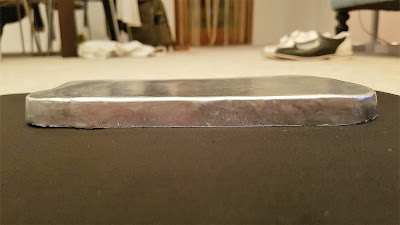Assignment 2

The Mould:
Each group received an STL file of the car which, after slicing, was able to be separated into 'parts'.
 3mm MDF sheets were bought from the workshop which were then put into a Laser Cutter. Once cut out we were able to assemble our templates as they slotted into one another, forming the car.
3mm MDF sheets were bought from the workshop which were then put into a Laser Cutter. Once cut out we were able to assemble our templates as they slotted into one another, forming the car.We then carefully covered the car with tape which allowed us to understand the shape of each section in more detail.
My Group of 5 decided to divided the car in parts that were either of similar form or location in order to create the car body in the most precise and efficient way, in my case I took responsibility for the roof and the back.
Part A: Roof
Steps:
1.) Using a large ruler, measure from the top to get rough dimensions of the roof panel.
Be sure to leave 5-15mm of additional length at every point on measure, as it's easier to cut down excess material than too try and stretch the aluminum out.
2.) Cut a piece of pre annealed aluminium to the dimensions you got from step 1.
3.) With the metal being annealed already we are able to push and form the metal against the mould with our hands to begin with.
This is very important when making the roof as this part is very visible and should be a smooth surface.
.Push along the y-axis to create the correct curvature down the length ways of the car
.Push along the x-axis to create the correct curvature that runs across the width of the car


4.) Use the English Wheel to get more accurate curvature, particularly in relation to the curve running along the shorter edge.
.The spine (middle) of the sheet will need more attention on the English Wheel as it needs to be stretched out to create a subtle curve- I suggest not using the English Wheel much around the edges.
Note that this step is the longest and the most important

5.) While forming a correct curvature down the spine always make sure not to let the back end of the sheet spring up and lose its shape- if it does you should still be able to push and form with your hands.


6.) Bend the rear wing at the end with your hands, note that it is not a straight bend
7.)Once you have moulded the correct curvature down the length of the roof. You can now cut more accurately the correct dimensions- note that the size of the roof will of changed dramatically in areas.
8.) Now you can use the metal shrinker (clamp like device) to tidy up the edges and make sure the correct curvature of the roof is the same to the edge.

9.) Re-cut if need be-finished



Part B: Back
Steps:
1.) With the use of a ruler roughly get the correct measurements for the back piece- (take the measurements as a rectangle).
2.) Cut the correct piece from pre-annealed aluminium.
3.) With your hands bend the metal around the back of the car to give you a correct curve from which will form the basis of your shape.

4.) You will notice that the back is not flat, there is a curve curve also going down the length of the piece.
To do this use a marker pen and mark how far down this curve is.
Then place your piece on a sandbag and hit with the narrow end of the mallet along the line you have drawn making sure the indentations remain straight.
Continue this process until the curve of the mould matches with that of your piece.
5.) Use your hands and the English wheel (but only on the edges) to re-bend the metal width ways so that both curves needed in this piece are correct.


6.)Re-cut where necessary
7.)Use the thick end of the mallet along the edges if any gaps appear along the edges, your aim is to get the piece as flush with the mould as you can.





Comments
Post a Comment